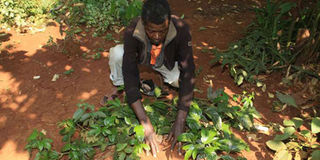‘Diseases of the poor’ wreak havoc as State response termed lethargic

Mr Samson Nyagwoka of Nyauno Village in Kisii County on August 3, 2016 shows the grave of his son Henry Nyabuto, who died after being bitten by a stray dog infected with rabies early this month. PHOTO | BENSON MOMANYI | NATION MEDIA GROUP
What you need to know:
- Online sources define NTDs as a group of tropical infections, which are especially common in low-income populations in the developing regions of Africa, Asia, and the Americas. They are caused by a variety of pathogens.
- The Ministry of Health created a department in 2013 and tasked it with coordinating and spearheading responses to this category of diseases. However, many Kenyans end up bearing costs of treating the diseases on their own.
- The Nation has established that in a county such as West Pokot, there is only one facility at Kacheliba Level Four Hospital handling cases Kala-azar - a form of tropical disease marked by emaciation, anaemia, fever and enlargement of the liver and spleen.
Major gaps still persist in efforts to prevent and treat what medics call Neglected Tropical Diseases (NTDs), even though there has been progress in the last two decades in Kenya’s healthcare, the Nation has established.
Online sources define NTDs as a group of tropical infections, which are especially common in low-income populations in the developing regions of Africa, Asia, and the Americas. They are caused by a variety of pathogens.
The Ministry of Health created a department in 2013 and tasked it with coordinating and spearheading responses to this category of diseases. However, many Kenyans end up bearing costs of treating the diseases on their own.
Kenya records high numbers of the diseases that appear on the World Health Organisation’s list of Tropical and Neglected Diseases. These include rabies, which claim more than 2,000 lives every year, according to the Zoonotic Disease Unit (ZDU); Human African trypanosomiasis, otherwise known as “sleeping sickness” and a host of other diseases, among them those spread by the sand fly, which is commonly found in the tropics.
There are also a few cases of crippling leprosy reported in a few counties in Kenya.
For those infected, availability of medication is always a challenge and drains up family resources. Most of the current interventions in managing the diseases are donor-funded.
There is no official data but reports from health facilities show that a handful of the patients lose their lives.
The Nation has established that in a county such as West Pokot, there is only one facility at Kacheliba Level Four Hospital handling cases Kala-azar - a form of tropical disease marked by emaciation, anaemia, fever and enlargement of the liver and spleen.
In the county, where 46 per cent of children are undernourished - the highest in Kenya, according to 2014 Kenya Demographic Health Survey — the locals are unaware that the ant hill looking mounds that allow them to feast on termites are the breeding grounds for sand flies.
The small, hairy, biting fly transmits a number of diseases including leishmaniasis, which affects the skin and internal organs of those infected.
Then there is rabies, a viral disease that, according to Dr Thumbi Mwangi, a veterinary epidemiologist, kills once signs start showing. Doctors can only manage the painful symptoms that characterise the patient’s last days such as dehydration and delirium among others.
In a ward at Siaya County Hospital, a woman who had been bitten by a viral dog barked like a dog, and then died the following day.
Her bed was next to that of Ms Pelesia Okong’o, who had been brought to the hospital when her wound started festering from a dog bite in June.
Speaking to the Nation from her home in Ong’ielo in Rarieda, middle-aged woman said: “I asked the doctor whether I was going to die like that. I saw her make those funny noises, clawing at people and fighting, looking like a dog for real”
Even though the infection left her with a limp, Ms Okong’o parted with Sh25,000 to treat herself.
At least 2,000 people die from rabies every year in Kenya, though fatalities that can be prevented by vaccinating dogs at a cost of less than Sh150.
The cost of administering post exposure prophylaxis (PEP) after being bitten by a dog is at least Sh9,000 per person, without which the bite victim dies if the dog was rabid.
Dr Mwangi says that rabies would be eliminated in less than five years if 70 per cent of dogs in Kenya would be vaccinated.
Director of Medical Services Jack Kioko says that lack of public awareness about vaccinations for dogs and failure to go for PEP in the event of a dog bite were major drawbacks.





